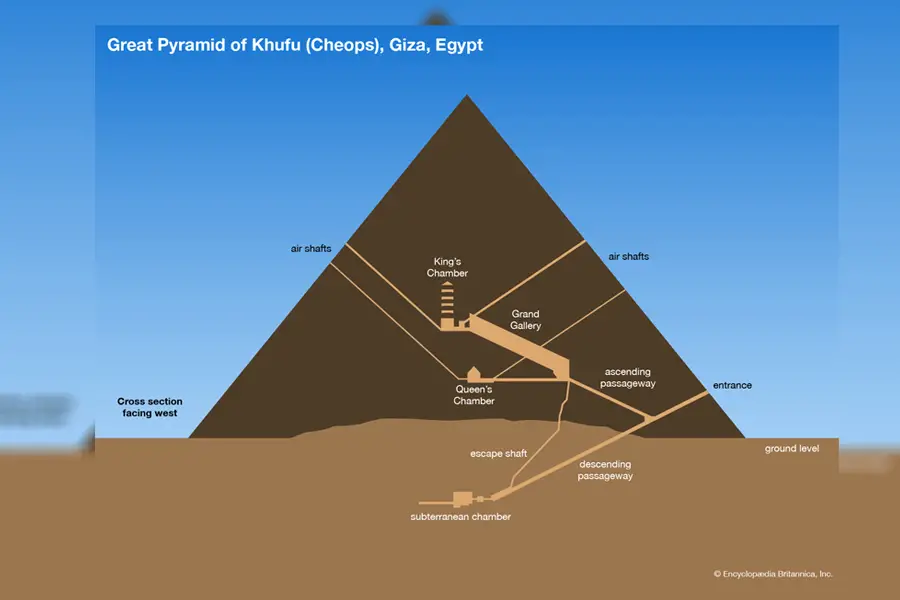The pyramids of Giza are probably the most popular man-made physical feature in Africa, which is known all around the world. These great structures have quite literally stood the test of time and continued to baffle many people about the building skills of the ancient Egyptians.
For centuries, the pyramids have attracted scholars and visitors to Egypt, and continue to attract more people to visit Egypt. In this article, we'll take a look at some of the facts that make the pyramids of Giza extremely interesting.
The 3 main pyramids as well as the great sphinx are surrounded by several cemeteries and the remains of a worker's village.

Pyramids Of Giza
1. What Is The Giza Pyramid Complex?
The Giza pyramid complex also called the Giza necropolis is comprised of the 3 main pyramids, the sphinx, and several smaller pyramids for Queens.
The main features of the Giza pyramid complex are;
- Khufu's complex - which has the oldest and biggest pyramid.
- Khafre's complex - which also includes the Great Sphinx
- Menkaure's complex - the smallest of the 3 main pyramids and the last to be built.
2. How Big Are The Pyramids Of Giza?
The 3 main pyramids of Giza are of different sizes, and we'll consider the base length and height as measurements of size.
| # | PYRAMID | BASE LENGTH | HEIGHT (CURRENT) | SLOPE / ANGLE |
|---|---|---|---|---|
| 1 | Pyramid of Khufu (The Great Pyramid) | 230.3 meters (756 ft) | 138.5 meters (454 ft) | 51.5 degrees |
| 2 | Pyramid of Khafre | 215.2 meters (706 ft) | 136.4 meters (448 ft) | 53.1 degrees |
| 3 | Pyramid of Menkaure | 102.2 x 104.6 meters | 61 meters (200 ft) | 51.2 degrees |
While the Pyramid of Khafre might seem taller, it is on raised ground which gives it the perception of being taller.
3. Who Built The Pyramids?
Popular theories suggest that pyramids were built by forced slave labour but archaeologists have excavated skeletons that would suggest native agricultural labourers from Egypt.
It is believed that the agricultural labourers would take up work on the pyramids, especially in times when the Nile would flood and make agriculture hard. The nearby worker's village near the Pyramid of Khufu was a well-planned dwelling, a fact that reinforces the use of native agricultural labourers from Egypt.
4. Why Were The Pyramids Built?
The pyramids were built to house the remains of the Pharaohs (kings) who ruled over ancient Egypt.
Ancient Egyptians believed that a part of the king's spirit stayed with his remains and that properly taking care of his remains was necessary for the former pharaoh to "perform his new duties as king of the dead"
5. How Old Are The Pyramids?
The pyramids of Giza are between 4480 and 4590 years old. They were built in the period between 2575 BC and 2465 BC for the pharaohs of the 4th dynasty. The oldest pyramid in Giza is the Great Pyramid of Khufu.
The pyramids in Giza are not the oldest in Egypt because the work of building pyramids started earlier in Dahshur some 40 kilometers south of Cairo.
6. What Is Inside The Pyramids

The pyramids were built to house the remains of former kings - and some of their treasures. During the medieval and middle ages, this treasure and remains were plundered, and thus there isn't so much to see inside the Egyptian pyramids of Giza.
Inside the pyramids are 3 main rooms and their accessways - the subterranean chamber, the queen's chamber, and the King's chamber. Inside you will also see the air shafts that bring air into the rooms of the pyramid.
7. Can You Go Inside The Giza Pyramids?
You can visit the Giza pyramids, and even go inside the pyramids - for a fee. Be aware fee for going inside the pyramids is separate from the entrance fees that allow you access to the outside of the pyramids and sphinx.
8. Are There Other Pyramids In Africa?

There are many other pyramids in Africa, from different times and places. In Egypt alone, there are other pyramids in Dahshur further south of Cairo and the number adds up to 132 pyramids.
Further south, in Sudan, is the Nubian or Kush pyramids that were built over centuries. While Sudan's pyramids are smaller and not quite as elaborate, they are more than 200 in number.
Final Thoughts
seeing the pyramids is about the curious wonder about humans and societies as a whole. The Egyptian pyramids are highly credited with the first steps of human civilization, and stepping into one is like stepping back in time - 5000 years ago.
While it is bad that the remains and treasures of the pyramids were raided, the significance of the pyramids to the world is hard to measure.
We hope you have enjoyed learning a few things about the great pyramids, and when it is possible, you can go and have a face-to-face with these unbelievable results of dedicated human effort.
